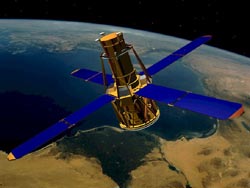RHESSI Will Use Venus Transit to Improve Measurements of the Sun's Diameter

Artist rendition of RHESSI spacecraft in orbit. Credit: NASA <br>
The satellite is pointed toward the sun, and constantly in rotation, which provides a serendipitous bit of side research: by monitoring the limb of the sun on its four second rotation cycle, RHESSI’s Solar Aspect System (SAS) has produced ten years worth of precise measurements of the sun's diameter.
This has already provided scientists with one of the most accurate measurements of what's called the oblateness of the sun, which is the difference between the diameter from pole to pole and the equatorial diameter. With the new data obtained during the Venus Transit on June 5-6, 2012, the RHESSI team hopes to improve the knowledge of the exact shape of the sun and provide a more accurate measure of the diameter than has previously been obtained.
For one thing, the sharpness of the Venus disk as it crosses the sun will help determine the detailed optical properties of the telescope and calibrate the instrument’s so-called plate scale, the exact angular size of each pixel. With this improvement in hand, RHESSI can re-calibrate its already highly accurate observations of the sun's horizon. To further this aim, the science team has set the instrument to look at 64 pixels across the sun's limb, rather than its customary four.
The RHESSI team has hopes that they may be able to provide an unprecedentedly accurate measurement of the sun's size.
With ten years of solar diameter measurements as well as observations of the Venus Transit in 2004 – a time when the sun's activity was decreasing toward solar minimum, as opposed to now when the solar activity is increasing as it moves toward solar maximum predicted for 2013 – the science team hopes to compare the sun's size then and now to see if perhaps it varies with the solar cycle.
Karen C. Fox
NASA's Goddard Space Flight Center
Media Contact
All latest news from the category: Physics and Astronomy
This area deals with the fundamental laws and building blocks of nature and how they interact, the properties and the behavior of matter, and research into space and time and their structures.
innovations-report provides in-depth reports and articles on subjects such as astrophysics, laser technologies, nuclear, quantum, particle and solid-state physics, nanotechnologies, planetary research and findings (Mars, Venus) and developments related to the Hubble Telescope.
Newest articles

Silicon Carbide Innovation Alliance to drive industrial-scale semiconductor work
Known for its ability to withstand extreme environments and high voltages, silicon carbide (SiC) is a semiconducting material made up of silicon and carbon atoms arranged into crystals that is…

New SPECT/CT technique shows impressive biomarker identification
…offers increased access for prostate cancer patients. A novel SPECT/CT acquisition method can accurately detect radiopharmaceutical biodistribution in a convenient manner for prostate cancer patients, opening the door for more…

How 3D printers can give robots a soft touch
Soft skin coverings and touch sensors have emerged as a promising feature for robots that are both safer and more intuitive for human interaction, but they are expensive and difficult…





















